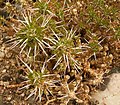Maihuenia patagonica
| Maihuenia patagonica | |
|---|---|

| |
| Scientific classification | |
| Kingdom: | Plantae |
| Clade: | Tracheophytes |
| Clade: | Angiosperms |
| Clade: | Eudicots |
| Order: | Caryophyllales |
| Family: | Cactaceae |
| Genus: | Maihuenia |
| Species: | M. patagonica
|
| Binomial name | |
| Maihuenia patagonica Phil. Britton & Rose
| |
| Synonyms[2] | |
| |
Maihuenia patagonica, commonly known locally as chupasangre or siempre verde, is a succulent cactus shrub native to Chile and Argentina. Maihuenia patagonica is remarkably tolerant to moisture and cold temperatures.[3]
Description
Maihuenia patagonica forms dense cushions about 30–40 cm (12–16 in) tall and 3 meters in diameter with densely-packed spines. It has a single, 40 cm (16 in) long taproot. The elongated shoots are not segmented and are loosely arranged. They are up to 40 centimeters long and have a diameter of 1 to 2 centimeters. There are numerous button-like to cylindrical, spur-like short shoots. The numerous green leaves are conical, ovoid or linear and circular to elliptical in cross section. They are 2 to 6 millimeters long and 1.5 to 3 millimeters in diameter. The single, stiff central spine is 3 to 7.5 centimeters long. The 2 marginal thorns (rarely only one or completely missing) are sometimes inconspicuous, sometimes lie on the surface of the shoot and are 2 to 8 millimeters long.
It blooms white to violet flowers usually appear terminally on short shoots. The elongated to almost spherical to club-shaped fruits are 2 to 4 centimeters long.[4]
The chromosome count is 2n = 22[5]
-
Plants
-
white flowers
Distribution
Maihuenia patagonica is widespread in southern Argentina and Chile at altitudes of up to 500 meters.
Taxonomy
The first description as Opuntia patagonica was published in 1863 by Rudolph Amandus Philippi. The specific epithet patagonica refers to the occurrence of the species in Patagonia.[6] Spanish common names are “Chupa Sangre”, “Siempre Verde”, and “Yerba del Guanaco”. Nathaniel Lord Britton and Joseph Nelson Rose placed it in the genus Maihuenia in 1919.[7]
References
- . Retrieved 12 February 2022.
- ^ The Cactus Expert. "Maihuenia patagonica".
- ^ "Maihuenia patagonica". Retrieved 13 February 2022.
- ISBN 3-8001-4573-1.
- ^ "Tropicos". Tropicos. Retrieved 2023-10-21.
- ISSN 0365-7779. Retrieved 2023-10-21.
- .
External links
 Data related to Maihuenia patagonica at Wikispecies
Data related to Maihuenia patagonica at Wikispecies Media related to Maihuenia patagonica at Wikimedia Commons
Media related to Maihuenia patagonica at Wikimedia Commons



